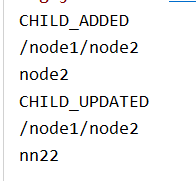Curator提供两种Watcher来监听节点的变化。
后文中的ct:
CuratorFramework ct;
@Before
public void before(){
ct = CuratorFrameworkFactory.builder()
//ip:端口
.connectString("192.168.10.132:2181,192.168.10.133:2181,192.168.10.135:2181")
//超时时间
.sessionTimeoutMs(5000)
//连接断开5秒后,会进行一次重连
.retryPolicy(new RetryOneTime(5000))
//命名空间,该命名空间作为父节点
.namespace("ct").build();
//打开连接
ct.start();
}
@After
public void after(){
ct.close();
}
1.Node Cache
只是监听某一个特定的节点,监听节点的新增和修改
//监视某个节点的数据变化
final NodeCache nodeCache = new NodeCache(ct, "/node1");
nodeCache.start();
nodeCache.getListenable().addListener(new NodeCacheListener() {
//节点变化时的回调方法
public void nodeChanged() throws Exception {
System.out.println(nodeCache.getCurrentData().getPath());
System.out.println(new String(nodeCache.getCurrentData().getData()));
}
});
Thread.sleep(100000);
nodeCache.close();
2.PathChildren Cache
监控一个ZNode的子节点,当一个子节点增加更新删除时。Path Cache会改变它的状态,会包含最新的子节点、数据和状态。
//第三个参数:事件中是否可以获取节点的数据
PathChildrenCache cache = new PathChildrenCache(ct, "/node1", true);
cache.start();
cache.getListenable().addListener(new PathChildrenCacheListener() {
//节点变化时的回调方法
public void childEvent(CuratorFramework client, PathChildrenCacheEvent event) throws Exception {
System.out.println(event.getType());
System.out.println(event.getData().getPath());
System.out.println(new String(event.getData().getData()));
}
});
Thread.sleep(100000);
cache.close();

3.事务
一系列操作要么全部成功,要么全部失败
//开启事务
ct.inTransaction()
.create().forPath("/w","w".getBytes())
.and()
.delete().forPath("/zxc")
//提交事务
.and().commit();